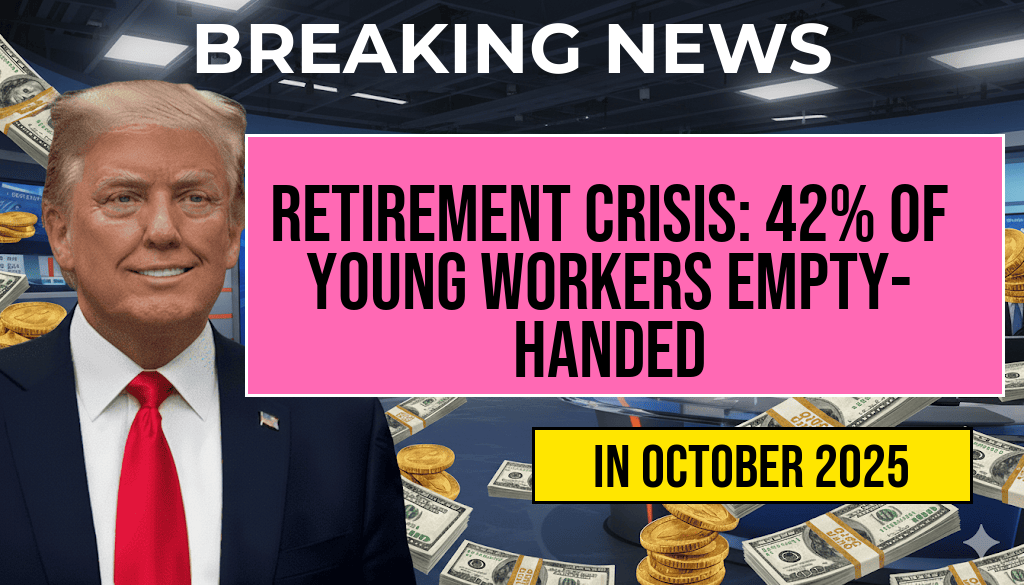Growing financial pressures and a shifting economic landscape have created a troubling scenario for many young American workers, as a recent survey reveals over 42 percent of individuals aged 25 to 34 lack any spare cash for retirement savings. Dubbed the “Financial Vortex,” this phenomenon illustrates how persistent debt, stagnant wages, and rising living costs trap many in a cycle of financial instability. Experts warn that without targeted interventions, a significant portion of the workforce risks entering retirement years with insufficient funds, potentially straining social safety nets and increasing reliance on public assistance programs.
The Scope of the Crisis
The latest report from the Employee Benefit Research Institute (EBRI) underscores a widening gap in retirement preparedness among younger Americans. According to the survey, nearly half of workers in their prime earning years are unable to set aside money for future needs. This trend is driven by multiple intertwined factors:
- Stagnant wage growth paired with rising living expenses
- High levels of student debt and other financial obligations
- Limited access to employer-sponsored retirement plans for some workers
Data from the Federal Reserve indicates that household debt reached a record high of $17.05 trillion in 2023, with student loans, credit cards, and auto loans comprising a significant share. Meanwhile, inflation continues to outpace wage increases, reducing disposable income and making it difficult for younger workers to contribute consistently to retirement accounts.
Understanding the “Financial Vortex”
What is the “Financial Vortex”?
The term describes a situation where economic challenges feed into one another, creating a self-perpetuating cycle of financial hardship. Young workers facing high debt levels often have little room to save, which hampers their ability to build wealth and secure a comfortable retirement. This cycle is exacerbated by factors such as job market volatility and unpredictable income streams.
Impact on Retirement Security
| Age Range | Average Retirement Savings | Percentage Without Savings |
|---|---|---|
| 25-34 | $13,000 | 42% |
| 35-44 | $45,000 | 35% |
| 45-54 | $96,000 | 28% |
This data illustrates a stark reality: a significant proportion of younger workers have little to no retirement savings, leaving them vulnerable to economic downturns and unforeseen expenses. Financial experts warn that delaying savings can lead to reduced compounding benefits, making it harder to accumulate sufficient funds over time.
Contributing Factors and Broader Implications
Wage Stagnation and Cost of Living
Real wages for many young Americans have remained flat for over a decade, while costs for housing, healthcare, and education continue to climb. According to the U.S. Census Bureau, the median rent increased by nearly 30% between 2010 and 2022, outpacing average income growth. This disparity leaves little room for discretionary income, much less retirement contributions.
Debt Burden
Student loan debt alone surpasses $1.6 trillion nationally, affecting roughly 45 million borrowers. The burden of debt repayment often takes precedence over retirement savings, especially for those just entering the workforce. The Federal Reserve reports that many young adults prioritize paying down debt before building retirement nest eggs, inadvertently extending their period of financial vulnerability.
Limited Access and Policy Gaps
While some employers offer retirement plans like 401(k)s, many small businesses and gig workers lack such benefits. Legislative efforts to expand access, such as state-sponsored retirement programs, are gaining traction but have yet to reach all demographics in need. Policy analysts suggest that comprehensive reforms are necessary to address structural barriers and promote savings among underserved populations.
Potential Solutions and Future Outlook
Addressing the “Financial Vortex” requires a multi-faceted approach involving policymakers, employers, and financial institutions. Initiatives such as automatic enrollment in retirement plans, enhanced financial literacy programs, and debt relief measures could help mitigate the crisis. For example, recent proposals advocate for incentivizing small employers to establish retirement options and expanding access to low-cost savings vehicles.
Role of Financial Education
Empowering young workers with knowledge about budgeting, debt management, and long-term planning can foster healthier financial behaviors. Studies indicate that early intervention and targeted education significantly improve retirement preparedness.
Policy and Industry Initiatives
- Expanding access to employer-sponsored retirement plans
- Implementing automatic enrollment and escalation features
- Offering student debt forgiveness or refinancing options
Organizations like the U.S. Department of Labor emphasize the importance of comprehensive policies to safeguard retirement security. Experts warn that without decisive action, the “Financial Vortex” could lead to a generation unprepared for retirement, amplifying economic disparities and placing additional strain on public assistance programs.
As the nation confronts these mounting challenges, fostering a culture of proactive savings and financial resilience emerges as key to breaking free from the cycle and ensuring future economic stability for younger Americans.
Frequently Asked Questions
What is the “Financial Vortex” and how does it affect younger workers?
The Financial Vortex refers to the cycle of financial challenges that trap many younger workers, making it difficult to save for retirement. This phenomenon leads to a lack of spare cash and hinders their ability to build retirement savings.
Why do 42 percent of younger workers have no spare cash for retirement?
Many younger workers face financial pressures such as high debt, low wages, and high living costs. These factors leave them with little to no disposable income to contribute to retirement funds.
What are the long-term consequences of lacking retirement savings?
Without adequate retirement savings, younger workers risk facing financial insecurity in their retirement years. This may lead to increased dependency on social programs or family support.
How can younger workers break free from the “Financial Vortex”?
Breaking free involves creating a budget, reducing debt, and starting to save early for retirement. Utilizing employer-sponsored plans and automatic contributions can also help build savings over time.
What role do employers and policymakers play in addressing this retirement savings crisis?
Employers and policymakers can support younger workers by offering retirement plans, providing financial education, and implementing policies that make saving for retirement more accessible and affordable for all.








